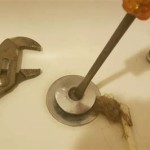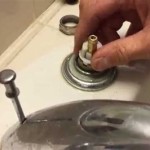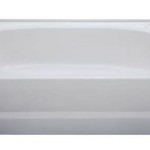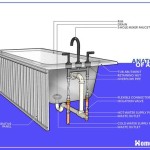Best Home Remedy To Unclog Bathtub Drain
A clogged bathtub drain is a common household nuisance that can disrupt daily routines and cause significant frustration. The slow drainage of water, the unpleasant gurgling sounds, and the potential for standing water create an unsanitary environment, fostering the growth of mold and bacteria. Addressing this issue promptly and effectively is crucial for maintaining a clean and functional bathroom. While commercial drain cleaners are readily available, they often contain harsh chemicals that can damage pipes and pose health risks. Fortunately, numerous home remedies offer safe and effective solutions for unclogging a bathtub drain, utilizing readily available household items and simple techniques. These remedies not only mitigate the immediate problem but also provide a cost-effective and environmentally conscious approach to drain maintenance.
Understanding the common causes of bathtub drain clogs is the first step in preventing future occurrences. Hair is the most prevalent culprit, intertwining with soap scum and other debris to form stubborn blockages. Soap residue itself accumulates over time, solidifying and narrowing the drainpipe. Mineral deposits from hard water can also contribute, gradually constricting the flow of water. Other potential obstructions include small objects like shampoo caps, pieces of toys, or even jewelry that may accidentally fall into the drain. Regular maintenance and preventative measures can significantly reduce the likelihood of these issues arising.
Before attempting any unclogging methods, it is essential to remove any visible debris from the bathtub drain. This includes hair, soap scum, and any other obvious obstructions that can be easily accessed. Wearing gloves is recommended to protect hands from bacteria and grime. Removing the drain stopper or screen allows for better access to the drainpipe and facilitates the unclogging process. Taking these preliminary steps ensures that the chosen home remedy can effectively target the underlying blockage.
The Power of Boiling Water
Boiling water is one of the simplest and most effective home remedies for unclogging a bathtub drain, particularly for clogs caused by soap scum or grease. The high temperature of the water helps to dissolve these substances, clearing the drainpipe. Before pouring boiling water down the drain, ensure that the bathtub material can withstand the heat. Porcelain and metal tubs are generally safe, but acrylic or fiberglass tubs may be damaged by the extreme temperature. If unsure, err on the side of caution and use a different method.
To use boiling water effectively, carefully pour a kettle or pot of boiling water directly down the drain. Avoid splashing, as the hot water can cause burns. Allow the water to sit for a few minutes to work its magic. If the drain is still clogged, repeat the process a few times. For more stubborn clogs, combine boiling water with other methods, such as using a plunger or a baking soda and vinegar solution. This simple remedy can often resolve minor clogs without the need for more aggressive measures.
The efficacy of boiling water lies in its ability to liquefy greasy substances and dissolve soap buildup. This is especially useful in households where oily bath products are frequently used. Regular flushing with boiling water, perhaps once a week, can help prevent the accumulation of these substances and maintain a clear drainpipe. This preventative measure is a low-cost and eco-friendly way to keep bathtub drains functioning optimally.
Baking Soda and Vinegar: A Dynamic Duo
The combination of baking soda and vinegar is a classic home remedy for unclogging drains, known for its fizzing action that helps to break down blockages. This method is safe for most types of pipes and is a more environmentally friendly alternative to chemical drain cleaners. The chemical reaction between baking soda and vinegar produces carbon dioxide gas, which can dislodge debris and clear the drainpipe.
To use baking soda and vinegar, start by pouring about one cup of baking soda down the drain. Follow this with one cup of white vinegar. The mixture will begin to fizz and bubble. Let it sit for approximately 30 minutes. During this time, the reaction will work to dissolve the clog. After 30 minutes, flush the drain with hot water. The hot water will help to rinse away the loosened debris and clear the drainpipe. If the drain is still clogged, repeat the process.
For particularly stubborn clogs, a variation of this method can be used. After pouring the baking soda down the drain, follow it with two cups of boiling water instead of vinegar. Let it sit for a few minutes, then pour in the vinegar. The boiling water will help to pre-soften the clog, making it more susceptible to the fizzing action of the baking soda and vinegar. This combination can be especially effective for clogs caused by hair and soap scum.
The baking soda and vinegar method is not only effective but also contributes to deodorizing the drain. The vinegar helps to neutralize odors, leaving the bathroom smelling fresher. Regular use of this method can help prevent the buildup of debris and maintain a clean and odor-free drain. This remedy is a simple and sustainable way to keep bathtub drains clear and functional.
The Reliable Plunger
A plunger is a versatile tool that can effectively dislodge clogs in a bathtub drain. The suction created by the plunger helps to break up the blockage and force it down the drainpipe. Using a plunger correctly is crucial for achieving the desired results. There are two main types of plungers: the cup plunger, which is suitable for flat surfaces like sinks, and the flange plunger, which is designed for toilets. For bathtubs, a cup plunger is generally sufficient.
Before using a plunger, ensure that there is enough water in the bathtub to cover the cup of the plunger. This creates a seal and allows the plunger to generate the necessary suction. If there is not enough water, add some until the plunger is submerged. It is also important to cover any overflow drains to prevent air from escaping and reducing the effectiveness of the plunger. A wet cloth or duct tape can be used to seal the overflow drain.
Place the cup of the plunger over the drain opening, ensuring a tight seal. Push down firmly and then pull up, maintaining the seal. Repeat this plunging motion vigorously for several minutes. The goal is to create a pressure difference that dislodges the clog. After several minutes of plunging, remove the plunger and check if the water is draining. If the drain is still clogged, repeat the process until the water flows freely.
For particularly stubborn clogs, adding a small amount of petroleum jelly around the rim of the plunger can help to improve the seal and increase the suction. This can make the plunging more effective, especially if the drain opening is not perfectly smooth. The use of a plunger is a manual and non-chemical approach to unclogging drains, making it a safe and reliable option for most households.
Preventing bathtub drain clogs is far easier than dealing with a fully blocked drain. Implementing a few simple preventative measures can save time and effort in the long run. Using a drain screen or strainer to catch hair and debris before they enter the drainpipe is a highly effective method. Regularly cleaning the drain screen and removing any accumulated debris prevents blockages from forming.
Another preventative measure is to flush the drain with hot water after each use. This helps to wash away soap scum and other residue, preventing them from solidifying and causing clogs. Pouring a cup of boiling water down the drain once a week can also help to dissolve any early-stage buildup. Avoiding the use of oily bath products can also reduce the likelihood of clogs, as these products tend to accumulate and contribute to blockages.
Regular maintenance, such as periodically pouring a baking soda and vinegar solution down the drain, can also help to keep the drainpipe clear. This method not only prevents clogs but also deodorizes the drain, leaving the bathroom smelling fresh. By incorporating these simple habits into a routine, homeowners can significantly reduce the risk of bathtub drain clogs and maintain a functional and sanitary bathroom.
When home remedies prove ineffective, it may be necessary to consider alternative solutions. A plumber's snake, also known as a drain auger, is a flexible tool that can be inserted into the drainpipe to break up or retrieve stubborn clogs. This tool is particularly useful for removing hair or other solid objects that are lodged deep within the drainpipe. A wet/dry vacuum can also be used to suction out debris from the drain. Place the hose of the vacuum over the drain opening and create a tight seal. The suction can help to dislodge and remove clogs that are beyond the reach of a plunger.

3 Simple Ways To Unclog A Bathtub Drain Naturally Wikihow

How To Easily Unclog Bathtub Shower Drain In 5 Minutes Jonny Diy

Unclog It Easy Home Remedies For Clogged Bathtub Drain Pros Verified

3 Simple Ways To Unclog A Bathtub Drain Naturally Wikihow

3 Simple Ways To Unclog A Bathtub Drain Naturally Wikihow

How To Unclog A Bathtub Drain Without Chemicals

How To Clear A Clogged Bathtub Drain This Old House

How To Unclog A Bathtub Drain Without Chemicals

Unclog It Easy Home Remedies For Clogged Bathtub Drain Pros Verified

Quick Tips To Unclog A Bathtub Drain Without Chemicals Plumbing Authority Inc








